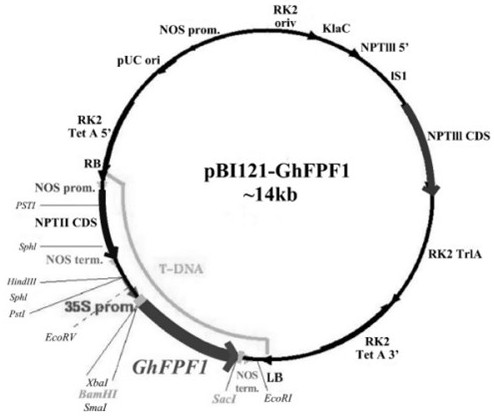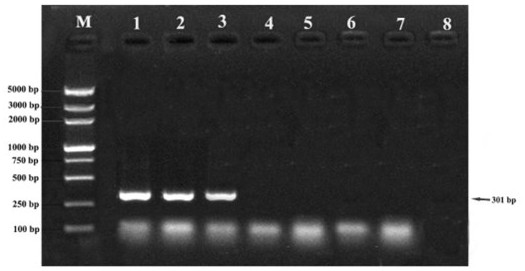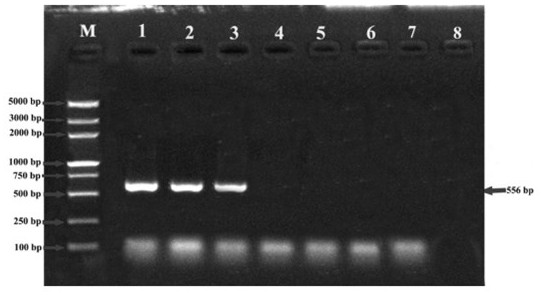Flanking sequence of GhFPF1 transgenic cotton insertion site and specificity identification method thereof
A technology of inserting sites and flanking sequences, which is applied in the determination/inspection of microorganisms, biochemical equipment and methods, DNA/RNA fragments, etc., and can solve the problem of foreign insertion of flanking sequences in transgenic GhFPF1 cotton. Articles and patent reports have not yet been found, etc. problem, to achieve the effect of easy supervision and management
- Summary
- Abstract
- Description
- Claims
- Application Information
AI Technical Summary
Problems solved by technology
Method used
Image
Examples
Embodiment 1
[0025] This embodiment provides a flanking sequence of a transgenic GhFPF1 gene cotton insertion site, which includes a left flanking sequence; the nucleotide sequence of the left flanking sequence is shown in the sequence table SEQ ID NO: 2, and its length is 937bp; the sequence of the 1st to 501st sites of the left flank sequence is derived from the genome sequence of China Cotton Research Institute 24, and the sequence of the 502nd to 937th sites of the left flank sequence is derived from the exogenous insertion of transgenic cotton with GhFPF1 gene Fragment sequence. Wherein, the left flank sequence refers to the left border flank sequence of the exogenous insert fragment of the transgenic GhFPF1 cotton.
Embodiment 2
[0027] This embodiment provides a kind of flanking sequence of transgenic GhFPF1 gene cotton insertion site, and it comprises right flanking sequence; The nucleotide sequence of described right flanking sequence is as shown in sequence table SEQ ID NO:3, and its length is 967bp; the 1st~466th site sequence of the right flank sequence is derived from the exogenous insert sequence of GhFPF1 gene transgenic cotton, and the 467th~967th site sequence of the right flank sequence is derived from the China Cotton Research Institute 24 genome sequence. Wherein, the right flank sequence refers to the right border flank sequence of the exogenous insert fragment of the transgenic cotton with GhFPF1 gene.
[0028] In addition, the acquisition method of the left flank sequence and the right flank sequence provided by the above-mentioned embodiments 1-2 is as follows:
[0029] (1) Extract the genomic DNA of the transgenic GhFPF1 cotton plant: take the young leaves of the transgenic GhFPF1 c...
Embodiment 3
[0033] This embodiment provides a specific identification primer for the flanking sequence of the insertion site of transgenic GhFPF1 cotton, and the primer is designed according to the left flanking sequence provided in the above-mentioned embodiment 1. Specifically, the primer includes a first primer; the first primer includes a first forward primer designed according to the 1st to 501st site sequence of the left flank sequence and a 502nd to 937th site according to the left flank sequence The first reverse primer designed by the sequence; wherein, the nucleotide sequence of the first forward primer is as shown in the sequence table SEQ ID NO: 4, which is: 5'-GCACCCAGATAATACGGGCT-3'; the first reverse primer The nucleotide sequence of the primer is shown in SEQ ID NO: 5 in the sequence table, which is: 5'-CCTTCAACGTTGCGGTTCTG-3'.
PUM
 Login to View More
Login to View More Abstract
Description
Claims
Application Information
 Login to View More
Login to View More - R&D
- Intellectual Property
- Life Sciences
- Materials
- Tech Scout
- Unparalleled Data Quality
- Higher Quality Content
- 60% Fewer Hallucinations
Browse by: Latest US Patents, China's latest patents, Technical Efficacy Thesaurus, Application Domain, Technology Topic, Popular Technical Reports.
© 2025 PatSnap. All rights reserved.Legal|Privacy policy|Modern Slavery Act Transparency Statement|Sitemap|About US| Contact US: help@patsnap.com



